Comprehensive Understanding of FTTx Network
What Is FTTx Network?
FTTx, or fiber to the “x”, is a collective term describing a wide range of broadband network architecture options. Those architectures utilize optical fiber for some or all of their last mile connectivity. The FTTx is a key method used to drive next-generation access (NGA), describing a significant upgrade to the broadband available by making a step change in speed and quality of the service. FTTx networks bring the combined advantages of higher transmission rates and lower energy consumption. The “x” stands for the fiber termination point, such as home, antenna, building, etc. Therefore, a FTTx network moves optical fiber closer to the user, which allows the latest construction, connection and transmission techniques to be leveraged to their fullest extent and diminishes the bottleneck of conventional coax.
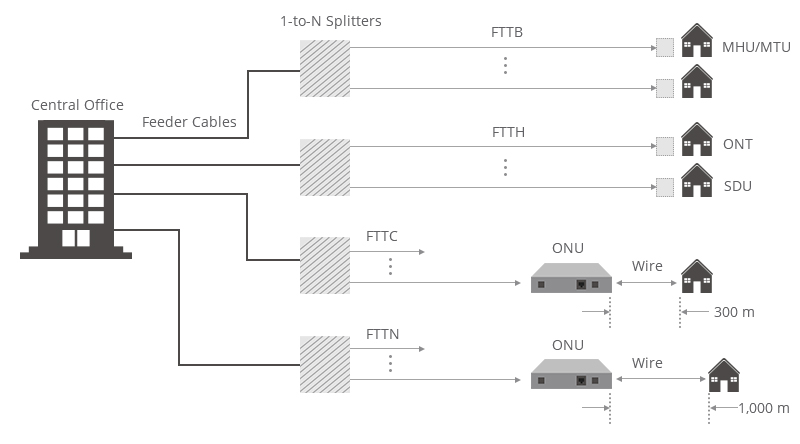
Figure 1: What Is FTTx Network
Understanding FTTx Network Architecture and Applications
According to different termination places, the FTTx network architectures or FTTx network types include FTTH, FTTA, FTTB & FTTP, FTTN, FTTC, etc. Listed below are the most common ones.
FTTH
FTTH, or fiber to the home, is certainly one of the fastest growing applications worldwide. In an FTTH deployment, optical cabling terminates at the boundary of the living space so as to reach the individual home and business office where families and officers can both utilize the network in an easier way.
There are three main types of FTTH network structures, namely home run, active star networks and passive optical networks (PON).
-
FTTH - Home Run: A home run architecture uses a direct fiber run from the central office (CO) to the home/customer. Each is a full duplex optical link, making this generally more expensive considering fiber and electronics requirements. It is usually used in some small systems like gated communities with 2 fibers, one digital for Internet and VoIP, the other for analog CATV. Some people refer to this as a point-to-point or P2P network.
-
FTTH - Active Star: An active star network uses fiber from the CO to a local active node carrying multiplexed signals to be distributed to all the customers. It contains a multi-fiber cable leading from the central office to a local network switch. At the active node, uninterruptible local power is needed if services like 911 are required. And this active star network may be a more expensive one due to the electronics and power needed since there is electronic switching for each customer and connectivity to a dedicated optical link to the premises.
-
FTTH - PON: The FTTH architecture consists of a passive optical network (PON) that allows several customers to share the same connection, without any active components (i.e., components that generate or transform light through optical-electrical-optical conversion). In this architecture, it usually needs a PON splitter. PON splitter is bi-directional, that is signals can be sent downstream from the central office, broadcast to all users, and signals from the users can be sent upstream and combined into one fiber to communicate with the central office. The PON splitter is an important passive component used in FTTH networks. Because it cuts the cost of the links substantially by sharing, this architecture is more prefered by people when choosing the FTTH architecture.
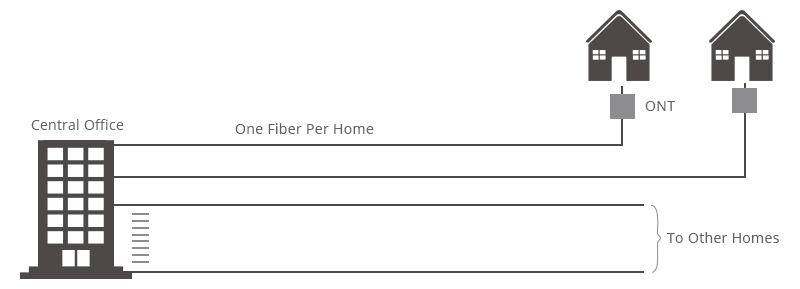
Figure 2: FTTH - Home Run Architecture

Figure 3: FTTH - Active Star Architecture
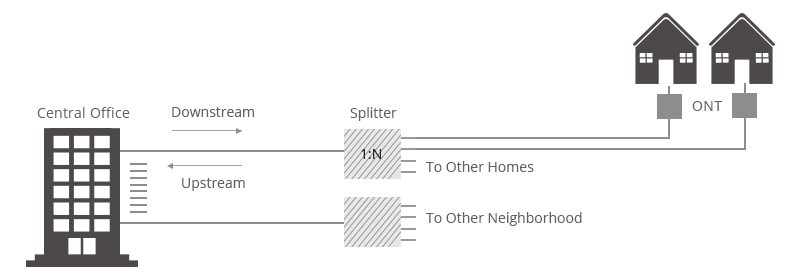
Figure 4: FTTH - PON Architecture
FTTA
FTTA, or fiber to the antenna, is a network architecture utilizing fiber optics to distribute the signals from a BBU (baseband unit) to a remote radio head (RRH) near the top of a cell tower, which is referred to as “fronthaul” in 5G. FTTA technology is an essential element of 5G, since massive MIMO (multiple-input and multiple-output) translates to more antennas and more cabling.
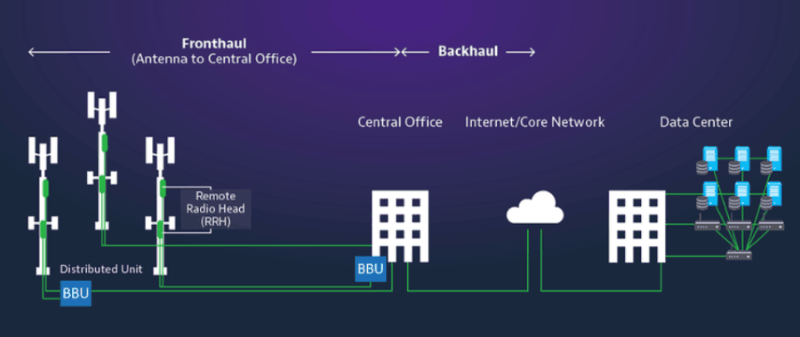
Figure 5: FTTA in 5G Application
FTTN
FTTN stands for fiber to the node. It is a network where the optical fiber ends at a street cabinet, with final connections being made through existing legacy copper or coaxial cables. FTTN deployments feature optical fiber that terminates at a node that lies only a few miles from the customer. From the node, copper or coax fiber spans in branches to the end user. Within the overarching FTTN designation, a few sub-categories exist.

Figure 6: FTTN Architecture
FTTC
As a type of FTTN, FTTC means fiber to the curb. It is a topology in which the fiber runs from a central office to a curb-side distribution point, such as in a pole or an enclosure, in the vicinity of customer premises. A FTTC network consists of fiber optic cabling ending within a short distance to the end user (usually around 300 meters).
FTTB
FTTB refers to fiber to the building or fiber to the basement deployment. In a FTTB network, optical cabling ends directly at the building. Yet, it is different from the typical Fiber to the Home scenario. FTTB deployments are often used to connect apartment blocks or other large buildings. In these cases, service providers bring a fiber line to a node within a building’s communication room. From there, they leverage existing copper wiring to provide network connectivity to each office or apartment within the overall building. Compared to FTTN and FTTC, FTTB is as close as network operators can get to FTTH while still using a node architecture.
Note: Fiber to the premises (FTTP) is a blanket designation including FTTH and FTTB.
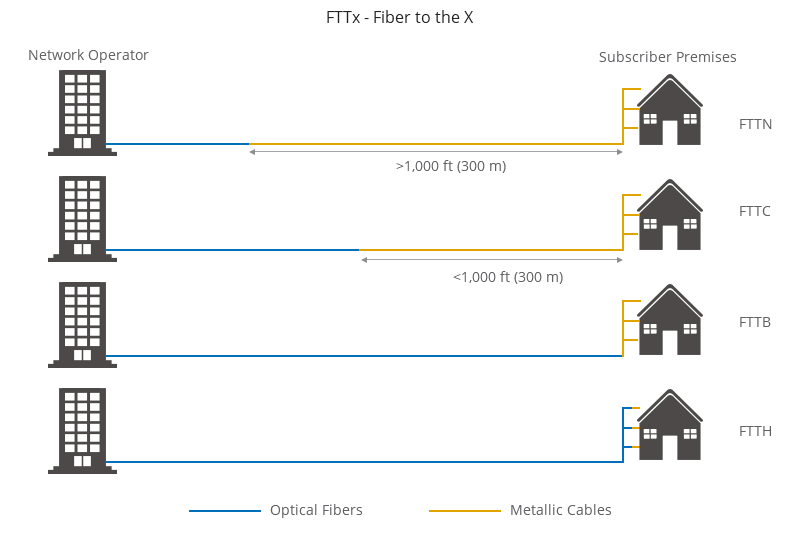
Figure 7: Diagram of FTTx Architecture
How Far Can FTTx Network Go?
Because of the development of cloud computing, smart cities and 5G, requirements for higher network speed and bandwidth have increased. FTTx can just meet these needs. The FTTx network provides the basic structure for low-latency, high-bandwidth fiber networks. Through this infrastructure, all current communication modes can achieve sufficient capacity and consistent connectivity. Extending the reach of a fiber network also provides long-distance signal transmission, a lightweight form factor, and immunity against electromagnetic interference. In addition, as the "x" creates unlimited flexibility, future FTTx options will be unlimited. The FTTx network deployment is expected to continue to accelerate in the next decade.
You might be interested in
Email Address

-
PoE vs PoE+ vs PoE++ Switch: How to Choose?
Mar 16, 2023














